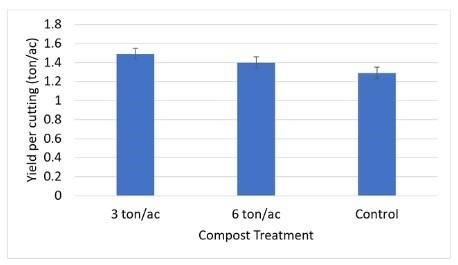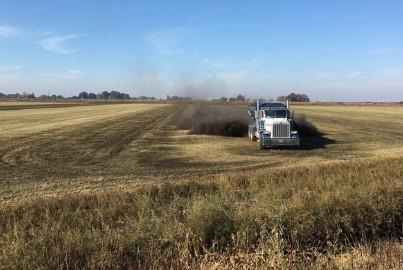By Michelle Leinfelder and Rachael Long et.al
Since Fall 2020, I have been evaluating the effects of applying green waste compost on established alfalfa. The three-year project includes two trials – one in the San Joaquin County Delta and the other in Yolo County – and is a collaboration with Rachael Long (UCCE) and Radomir Schmidt (UC Davis). The project is supported by a CA Department of Food and Agriculture Healthy Soils Program (CDFA HSP) demonstration grant. Our interests are in evaluating whether compost enhances soil carbon and nitrogen storage, improves soil physical characteristics (i.e. improved water infiltration, reduced compaction), reduces greenhouse gas emissions, and/or boosts alfalfa yield.
Compost is decomposed organic matter from plants or animals and may be classified by the carbon-to-nitrogen ratio (C:N). The C:N is the relative amount of carbon and nitrogen in the material. Plant-derived composts (like green waste compost) have a high C:N, and animal-derived composts (like composted manures) have a low C:N. A material with a ratio greater than 30:1 is considered a high C:N material. The ratio is important because it affects microbial metabolic functioning and plant-available nitrogen. Both high and low C:N composts promote soil functioning by increasing soil carbon that is in a form easily accessible to microbes. That, in turn, can improve soil biological activity and physical conditions. With a high C:N material, however, nitrogen may be immobilized (“tied up”), so soil nutrient monitoring is important in order to stave off impacts to crops.
The San Joaquin County trial is approximately 20 acres, and there is no history of compost application at the site. The soil is a Peltier mucky clay loam that is considered partially to poorly drained. Compost applications are surface-applied in the fall/winter to plots that are two border checks wide (120 ft) and approximately 1000 ft long. Two green waste compost rates – 3 tons/ac and 6 tons/ac – are being compared to the untreated (non-composted) control. The first compost application was made in Fall 2020 following the first cutting season of the alfalfa stand. The second application was made in Winter 2021, and the final will occur in fall/winter 2022. Baseline soil samples were collected at the beginning of the study (October 2020), and annual sampling is done every fall season before compost application. Alfalfa yield is assessed 3-4 times per year by taking quadrat samples from the grower's windrows. Greenhouse gas samples are collected on a monthly basis.
Preliminary results. Yield was measured from three cuttings in 2021, and so far, from two cuttings in 2022. (We anticipate measuring yield from two more cuttings in 2022.) Our preliminary results from these five cuttings indicate that compost can improve alfalfa yield over the untreated control but that a rate of 6 tons/ac does not improve yield over the 3 tons/ac rate (Fig. 1). We are also testing forage quality, and those results will be available in the fall.
I recently held a field day at the trial location. If you were not able to make it, please visit my website for the handouts. The handout “Compost for Soil Improvement in Alfalfa” shows other preliminary results from this trial, including soil carbon and nitrogen and greenhouse gas emissions. In addition, there are handouts describing other organic matter amendments in alfalfa and forages.

Figure 1. Preliminary yield results over five cuttings in 2021 and 2022. The compost rate of 3 tons/ac improved alfalfa yield over the untreated control.
Conclusions. Organic matter amendments, as from compost, can improve soil functioning, but changes take time to observe, let alone be realized financially. We estimate that compost (material plus hauling) costs approximately $27/ton, with an additional $10/ton for spreading (Fig. 2). To help offset the costs, the CDFA HSP provides incentives grants for farmers, and more funding may be available later this year. UC ANR Technical Service Providers Hope Zabronsky or Caddie Bergren are available to help growers with the application. And please don't hesitate to reach out to me if you would like more information on this trial or on the CDFA incentives programs.

Source : ucanr.edu